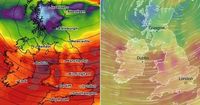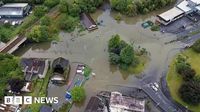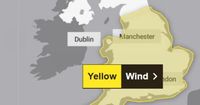Storm Amy, a fierce weather system that swept across the United Kingdom starting late Sunday, September 14, 2025, left a trail of disruption in its wake as it battered England and Wales with winds approaching 80 mph, torrential rain, and widespread flooding. The Met Office, the UK's national weather service, issued a yellow weather warning for wind, covering all of England and Wales from Sunday evening until 6pm on Monday, September 15. The warning advised residents to brace for hazardous conditions, including the risk of flying debris, falling trees, and major travel delays.
According to the BBC, the strongest gusts were recorded in Aberdaron, Gwynedd, where winds reached 66 mph (106 km/h), and Capel Curig in Conwy, which saw gusts of 59 mph (95 km/h). Meteorologists anticipated even higher gusts at exposed sites such as the Needles on the Isle of Wight, where British Weather Services meteorologist Jim Dale warned of nearly 80 mph winds. "This 'storm' has not officially been named, but it's a very close call, and it's in for the rest of today. There could be almost 80mph gust at the Needles, Isle of Wight, with 50 to +60mph at other exposed sites," Dale told the Mirror. "Some structural damage is inevitable, combined with some localised flooding in western seas, particularly."
The impact of Storm Amy was felt from the moment it made landfall around 10pm on Sunday. By Monday morning, the effects had rippled across the country, with North Wales and Merseyside bearing the brunt just before 11am. The Met Office's warning extended to the likelihood of large waves battering coastal areas, urging people to stay away from the shore and to exercise caution if walking near cliffs. The advisory also highlighted the risk of travel disruption and power outages, a prediction that proved accurate as the storm progressed.
In Wales, the situation quickly turned critical. Flooding submerged cars on the Cwmbwrla roundabout on Carmarthen Road in Swansea, prompting emergency services to evacuate families from nearby homes. William Leggatt, a local resident, described the surreal scene to the BBC: "I ran down to see if I could help anyone but fire and rescue had the boats in place and ready. They were evacuating families from the houses around the corner. No-one has really seen anything like this previously. Obviously it's a bit devastating. The generators were on fire yesterday. There was a gas leak over there, you could hear it and smell it in the area, but the kids thought it was fun and games. There was a swimmer in there yesterday, diving off the cars, there was a paddleboarder going around. It was a bit of entertainment for everyone but [they didn't realise] the risk."
Power outages were widespread. The National Grid reported that 460 homes were without power in south, west, and mid Wales by early Monday afternoon, with the largest outage affecting 123 properties in Fairwater, Cardiff. Additional cuts hit Barry, Swansea, St Clears, Aberdare, Merthyr Tydfil, Rhyl, Denbigh, Llanberis, and Morfa Nefyn. In north Wales, SP Energy Networks confirmed outages in the Llanaelhaearn area of Gwynedd. Across the border, UK Power Networks reported that 740 homes in Essex, 420 in Norfolk, 285 in Cambridgeshire, and 283 in Suffolk were also affected by outages.
The storm’s ferocity brought down trees across the country, blocking roads and damaging infrastructure. In Norfolk, Ingoldisthorpe Primary School was forced to close after a tree fell and took down a power line. The A11 southbound at Bridgham, Norfolk, was also closed due to a fallen tree, causing significant travel delays. On Sunday in Fressingfield, Suffolk, four people were trapped in a car after a tree branch pierced the vehicle. Suffolk Fire and Rescue Service successfully rescued all occupants, who were then treated by paramedics.
Community spirit shone through in places like Milton, near Cambridge, where a large tree blocked Coles Road. Residents, joined by a local farmer with his digger, worked together to clear the debris and restore access to the village. Meanwhile, experts warned that the exceptionally dry summer had increased the risk of falling branches during high winds, compounding the danger for both motorists and pedestrians.
The storm’s impact extended beyond homes and roads. Many attractions and institutions closed their doors for safety. Whipsnade Zoo in Bedfordshire announced a full-day closure due to "adverse weather," while several National Trust properties—including Felbrigg Hall, Oxburgh Estate, Lyveden, Lavenham Guildhall, and Stowe House—shut to the public. The closure of Stowe House’s gardens also led to the cancellation of a scheduled Heritage Open Day. Burghley House, Bressingham Steam and Gardens, and Hedingham Castle, which had planned an Andrea Bocelli outdoor cinema screening, were among other venues forced to cancel events or close entirely.
Travelers faced further headaches as the M48 Severn Bridge was closed and the Cleddau crossing in Wales was shut to high-sided vehicles, according to BBC reports. The Met Office’s meteorologist Tom Morgan predicted that the strongest winds would hit west Wales and northwest England on Monday morning, with conditions gradually easing from the west later in the afternoon and into the evening. “People need to be aware of flying objects and trees in leaf. The winds should ease off overnight,” Jim Dale reiterated.
Thunderstorms added to the chaos in northern England, with locations such as Morecambe, Fleetwood, Blackpool, and Lancaster expecting up to 10mm of rain within just three hours. Showers persisted across much of the UK, especially in northern Scotland, Northern Ireland, and western England, while London and the Southeast largely escaped the worst of the rainfall, though light showers remained possible.
Authorities repeatedly urged the public to secure loose items around their homes and gardens, check for travel delays and road closures, and exercise extreme caution near the coast. The Met Office’s warning read: “If you are on the coast, stay safe during stormy weather by being aware of large waves. Even from the shore, large breaking waves can sweep you off your feet and out to sea. Take care if walking near cliffs; know your route and keep dogs on a lead. In an emergency, call 999 and ask for the Coastguard.”
As the storm’s low pressure system tracked into the North Sea by Monday evening, the UK began the slow process of recovery. While the winds gradually eased, the widespread disruption underscored the country’s vulnerability to extreme weather events and the importance of preparedness in the face of nature’s unpredictability.



